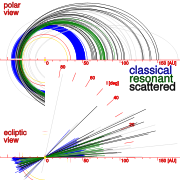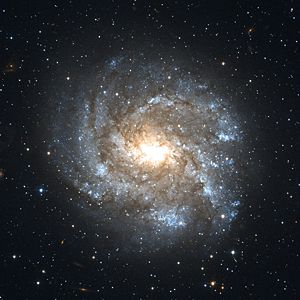Portal:Astronomy
2008/9 Schools Wikipedia Selection. Related subjects: Portals; Space (Astronomy)
Astronomy ( Greek: αστρονομία = άστρον + νόμος, astronomia = astron + nomos, literally "law of the stars") is the study of the evolution and physical and chemical properties of celestial objects. Astronomical observations are not only relevant for astronomy as such, but provide essential information for the verification of fundamental theories in physics, such as the general relativity theory. Complementary to observational astronomy, theoretical astrophysics seeks to explain astronomical phenomena.
The scattered disc (or scattered disk) is a distant region of the Solar System that is sparsely populated by icy minor planets known as scattered disc objects (SDOs); a subset of the broader family of trans-Neptunian objects (TNOs). The scattered disc objects have orbital eccentricities ranging as high as 0.8, inclinations as high as 40°. The perihelion distances of SDOs are greater than 30 astronomical units (AU). These extreme orbits are believed to be the result of gravitational " scattering" by the gas giants, and the objects continue to be subject to perturbation by the planet Neptune.
While the nearest distance to the Sun approached by scattered objects is about 30–35 AU, their orbits can extend well beyond 100 AU. This makes scattered objects "among the most distant and cold objects in the Solar System". The innermost portion of the scattered disc overlaps with a torus-shaped region of orbiting objects known as the Kuiper belt, but its outer limits reach much farther away from the Sun and farther above and below the ecliptic than the belt proper.
Recently featured: Venus – White dwarf – Callisto
| Read more... |
NGC 2082 spiral galaxy in Dorado constellation.
The image is omposite of several shots taken by Hubble Space Telescope on September 11, 2002 using ACS instrument with 435 nm (blue) and 814 nm (red) wavelength filters. Colour image processed by WikiSky team.
...that Zeeman-Doppler imaging is a technique used to map the surface magnetic field of stars?
...that Astronomische Nachrichten, founded by H. C. Schumacher in 1821, is the world's oldest extant astronomical journal?
...that the Stingray Nebula, thought to have formed around 1987, is the youngest known planetary nebula?
...that the Mark II radio telescope built in 1964 at Jodrell Bank Observatory, UK was the first ever telescope to be controlled by a digital computer?
...that Comet Shoemaker-Levy 9 passed within Jupiter's Roche limit in 1992, causing it to break up into smaller pieces two years before it collided with the planet?
...that the Kaidun meteorite fell on March 12, 1980 on a Soviet military base in Yemen and may be from Phobos?
...that Pluto is now considered the 2nd largest member of the Kuiper belt after its retirement as the 9th planet?



